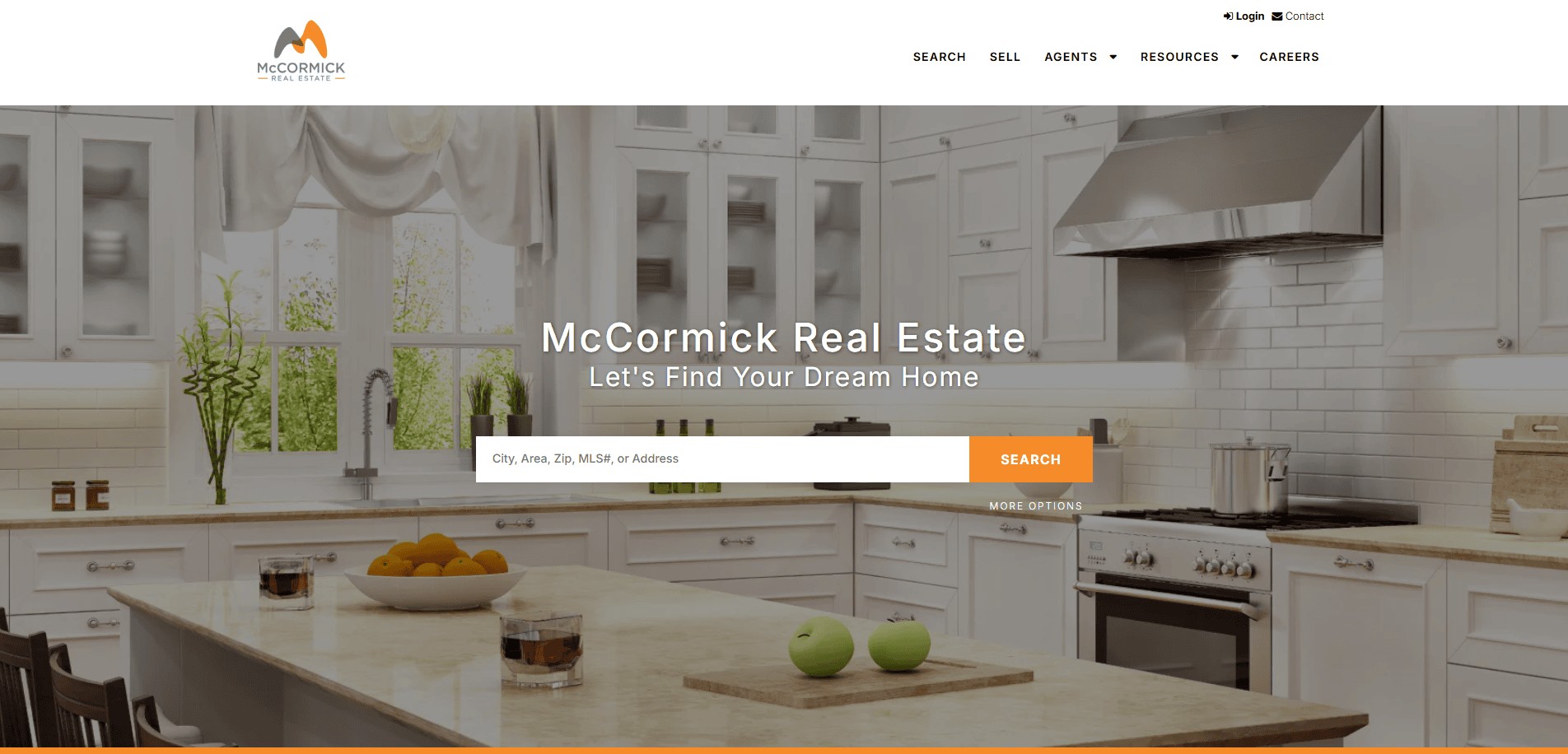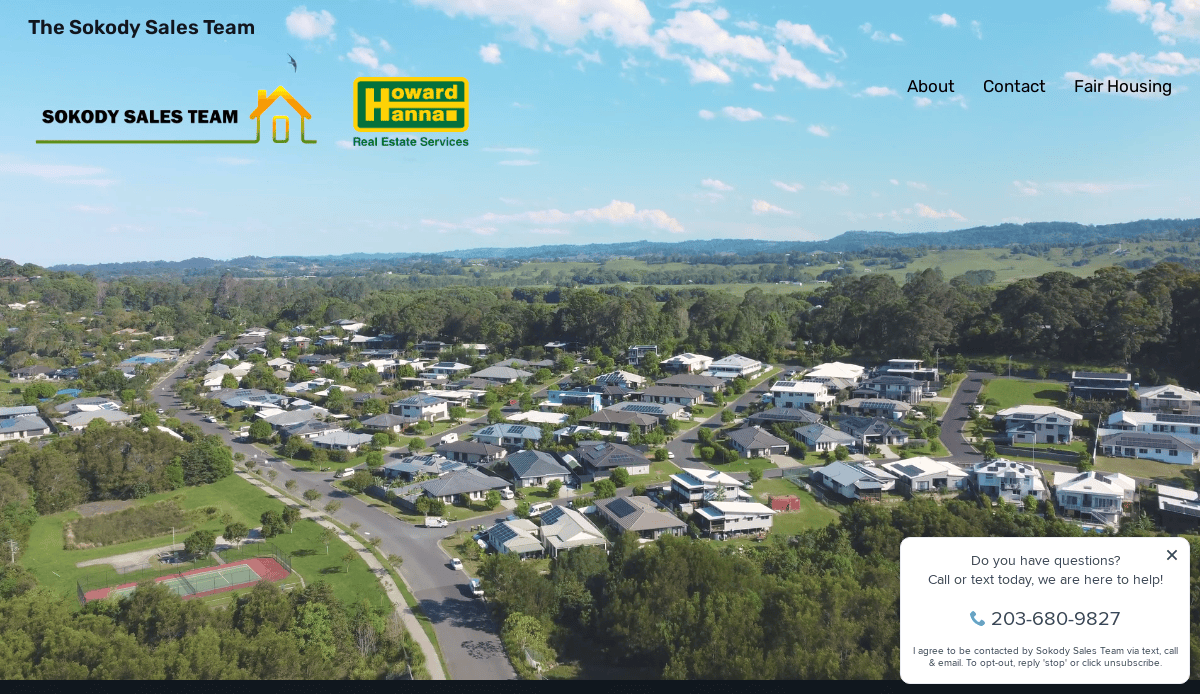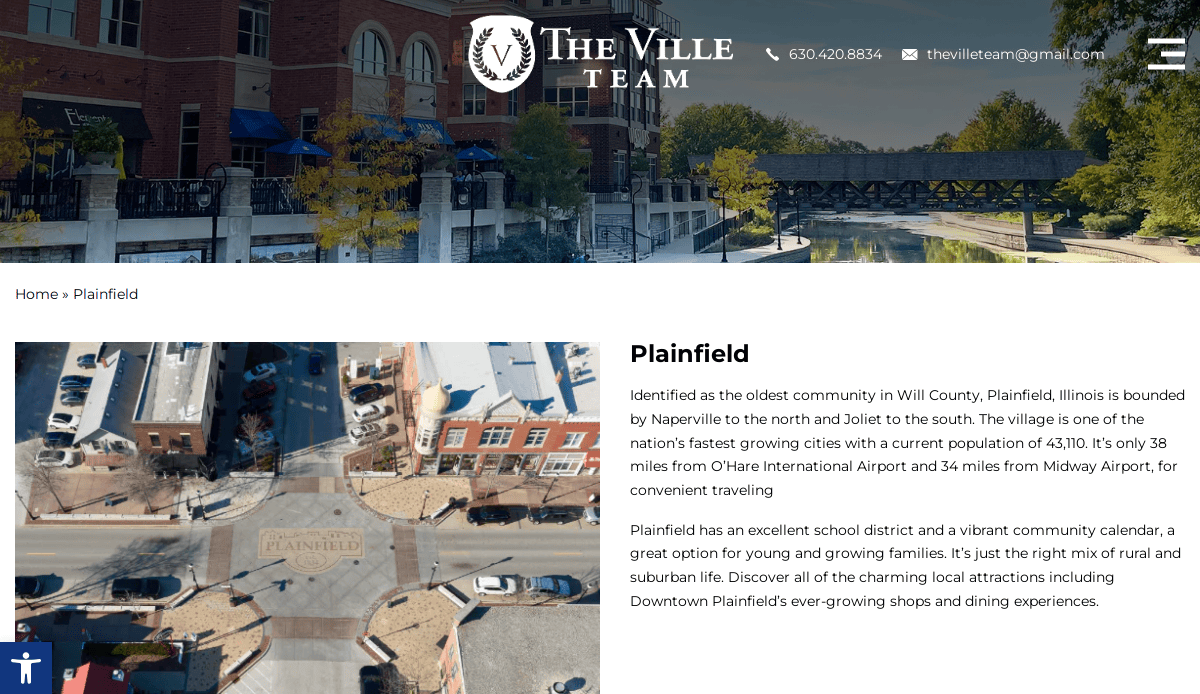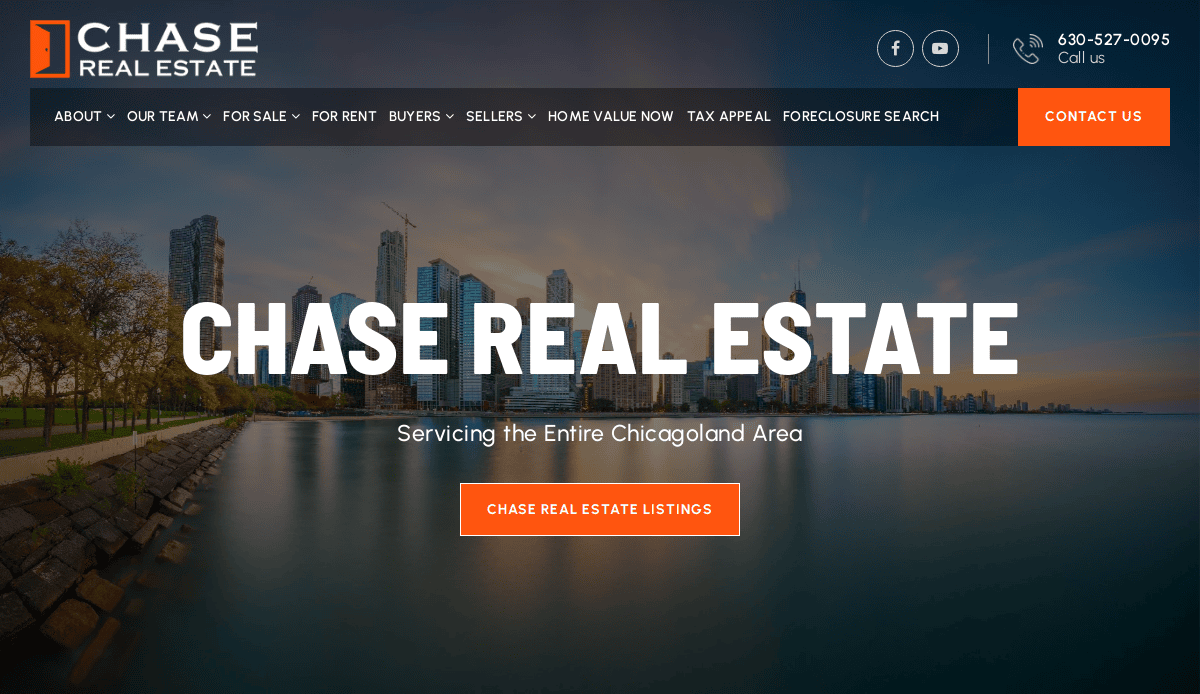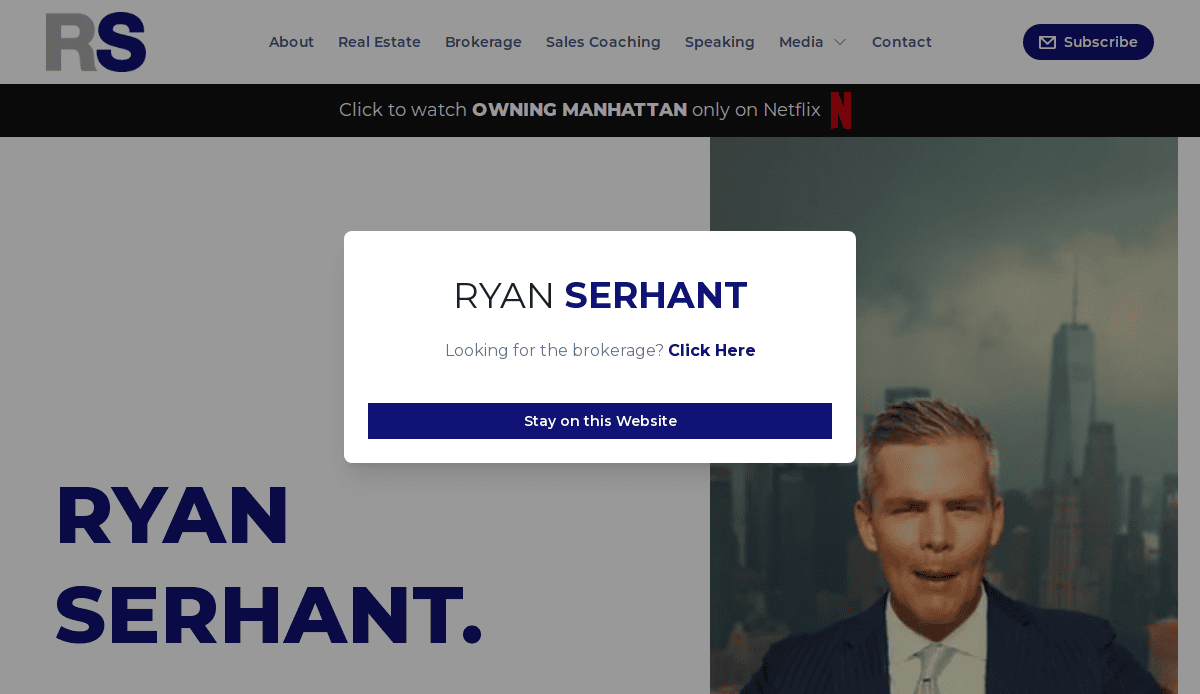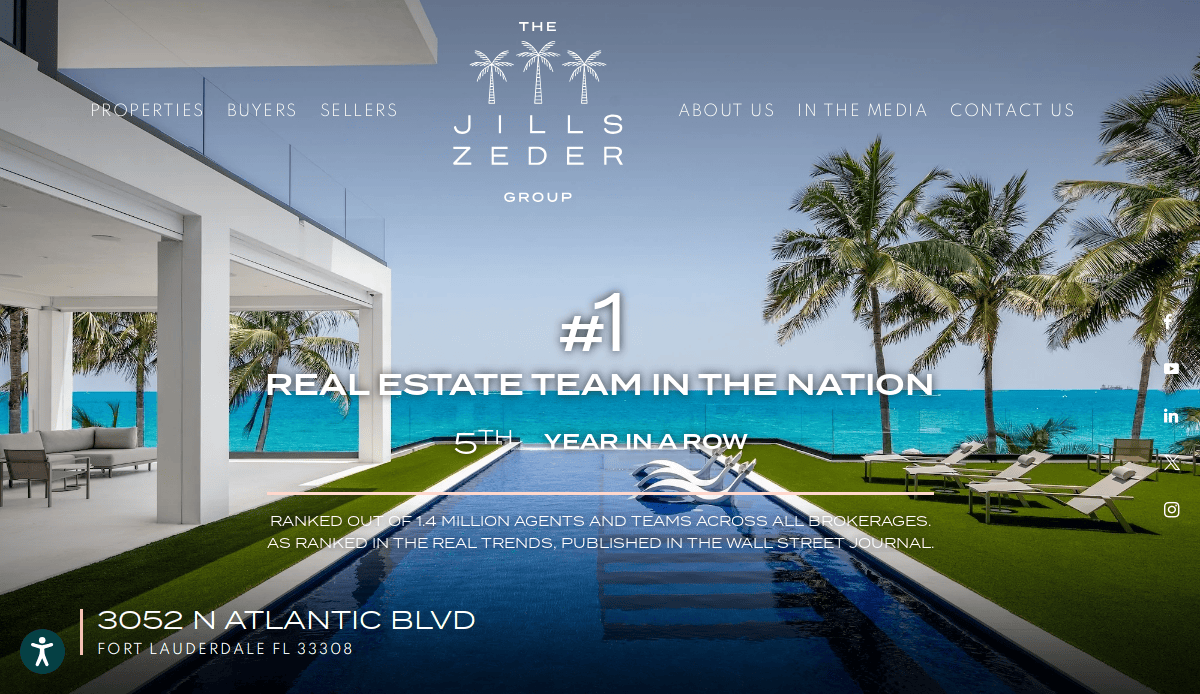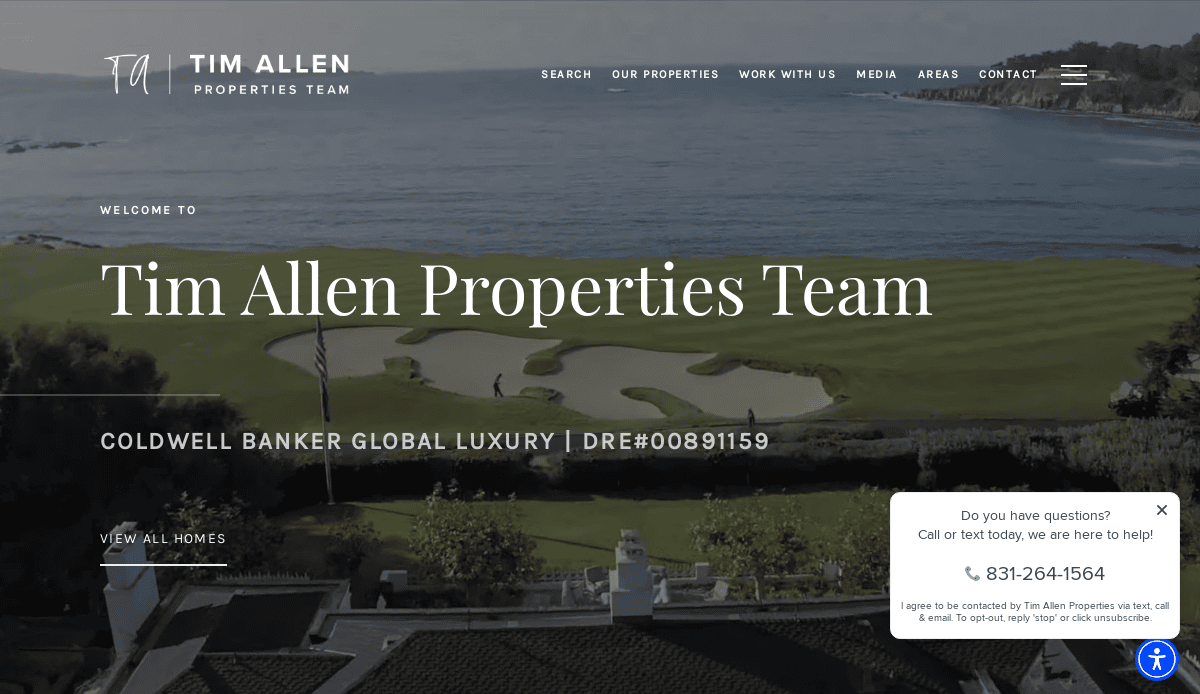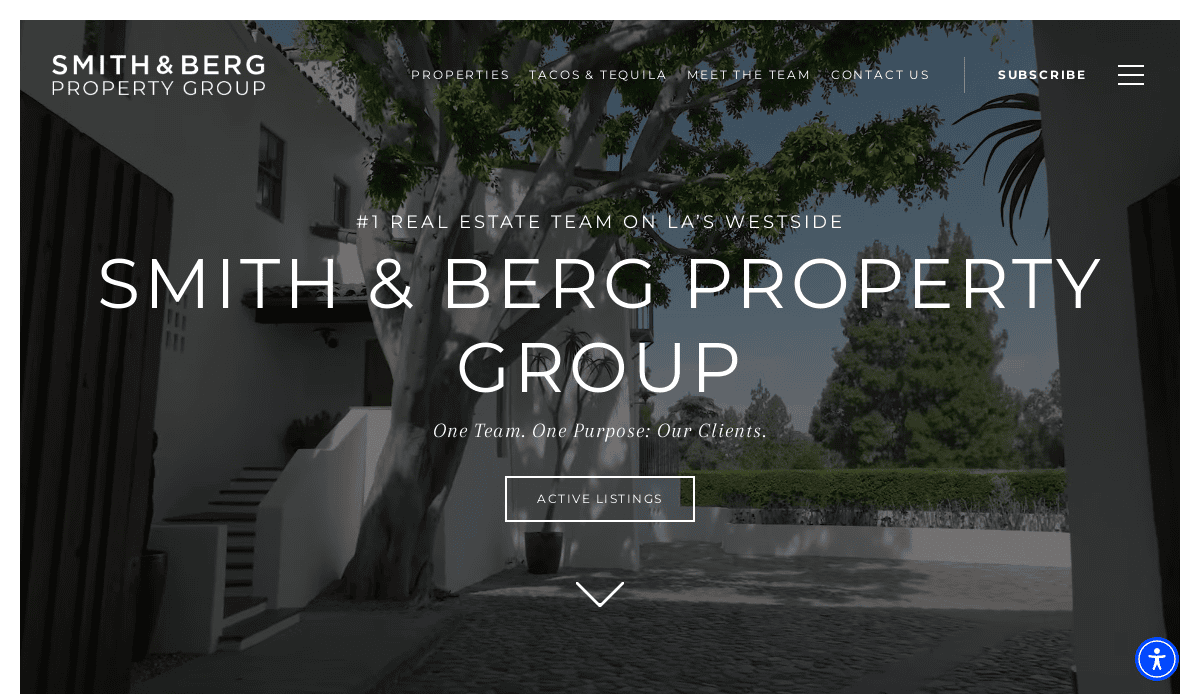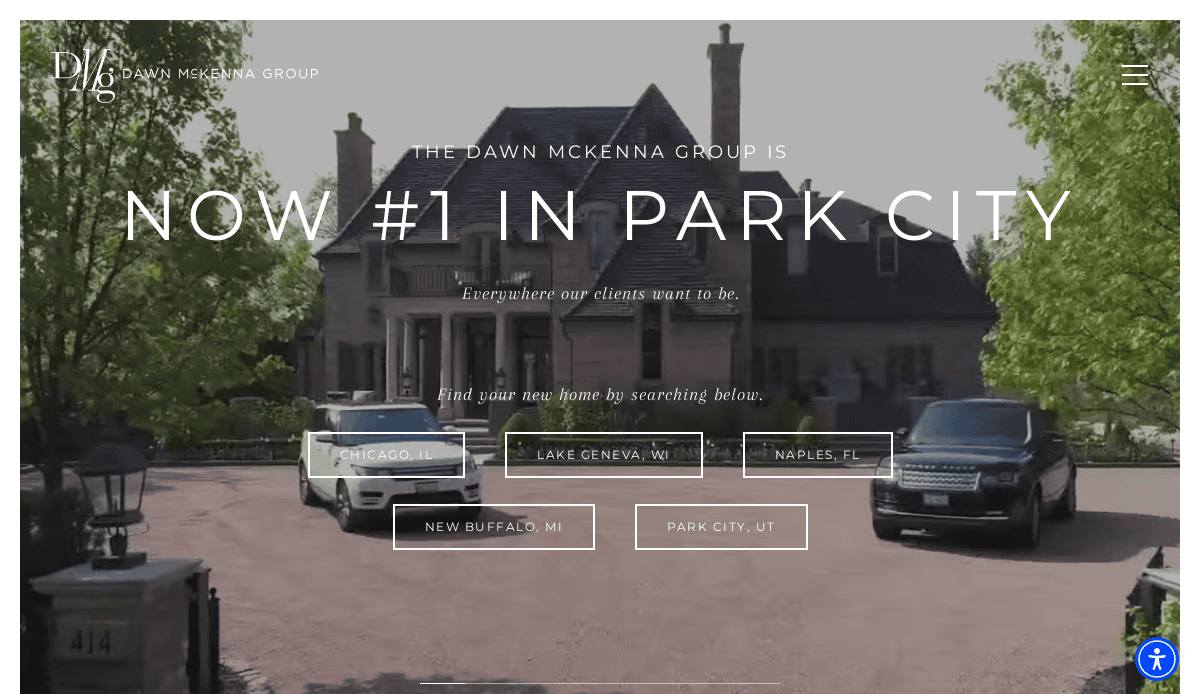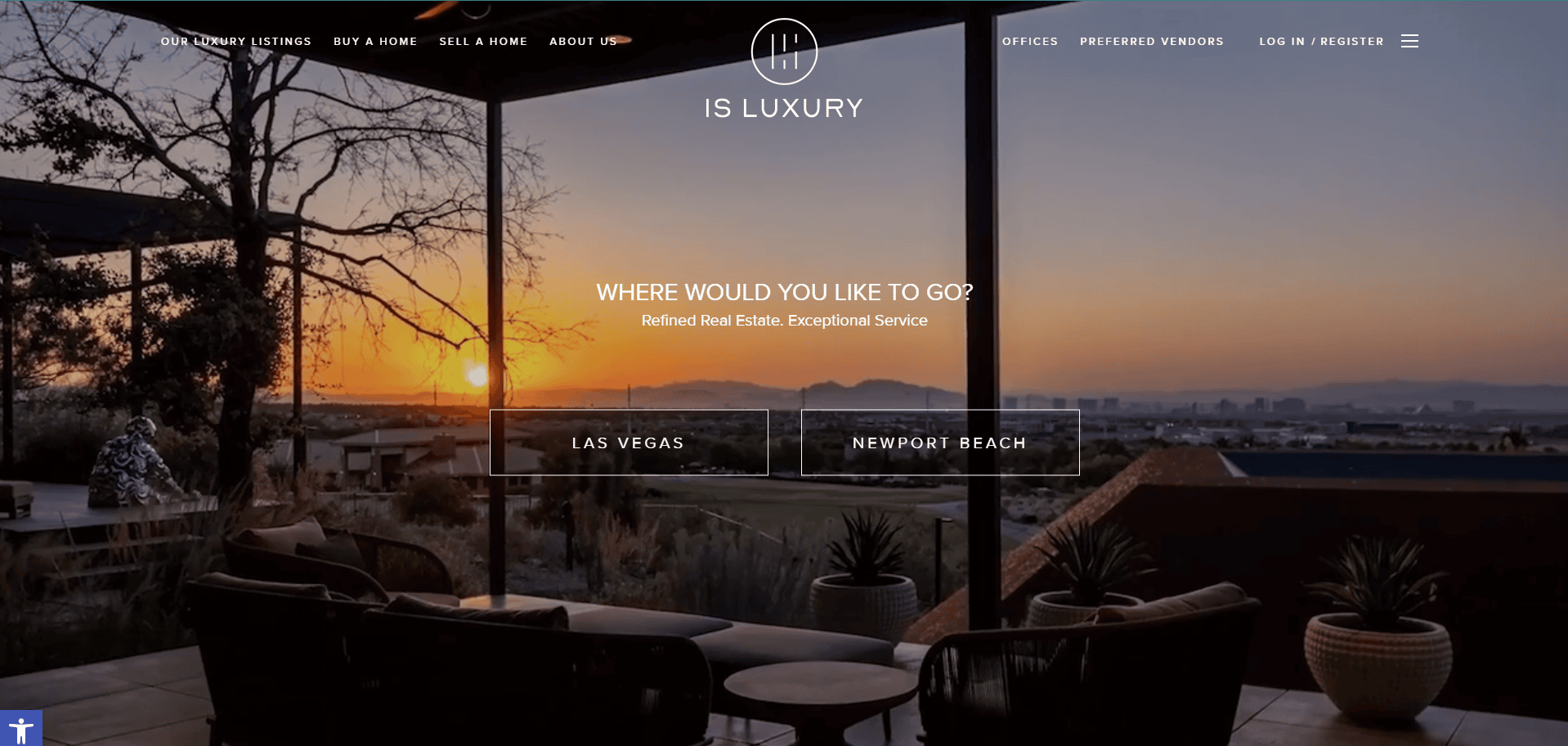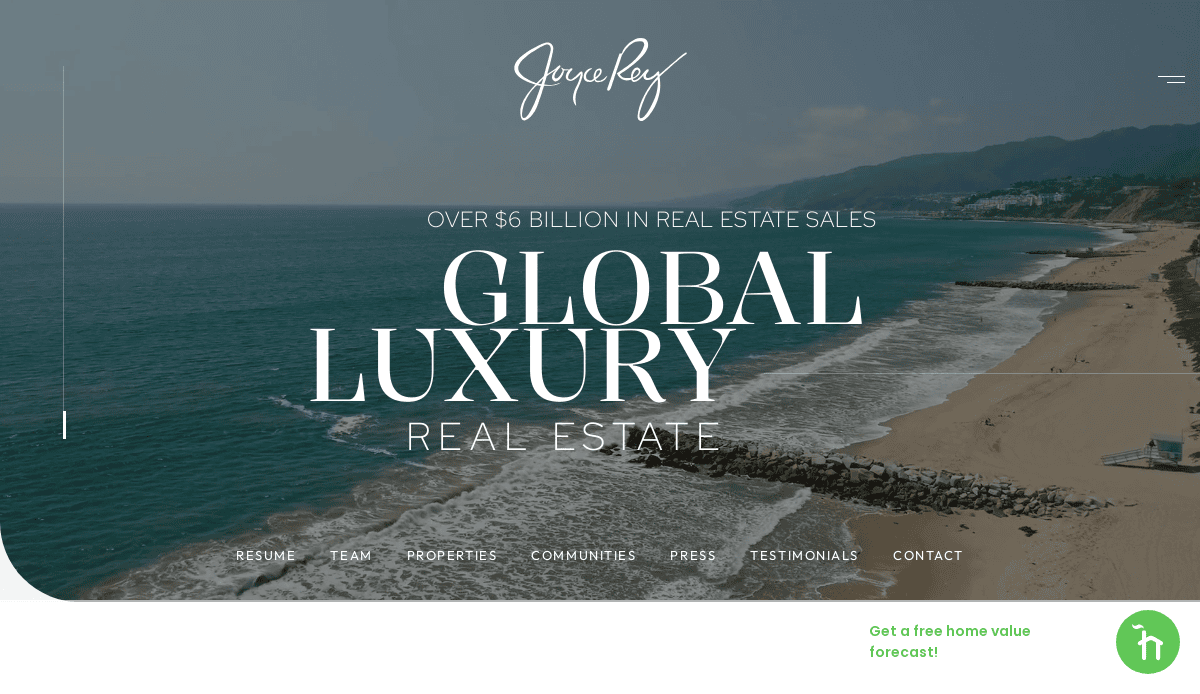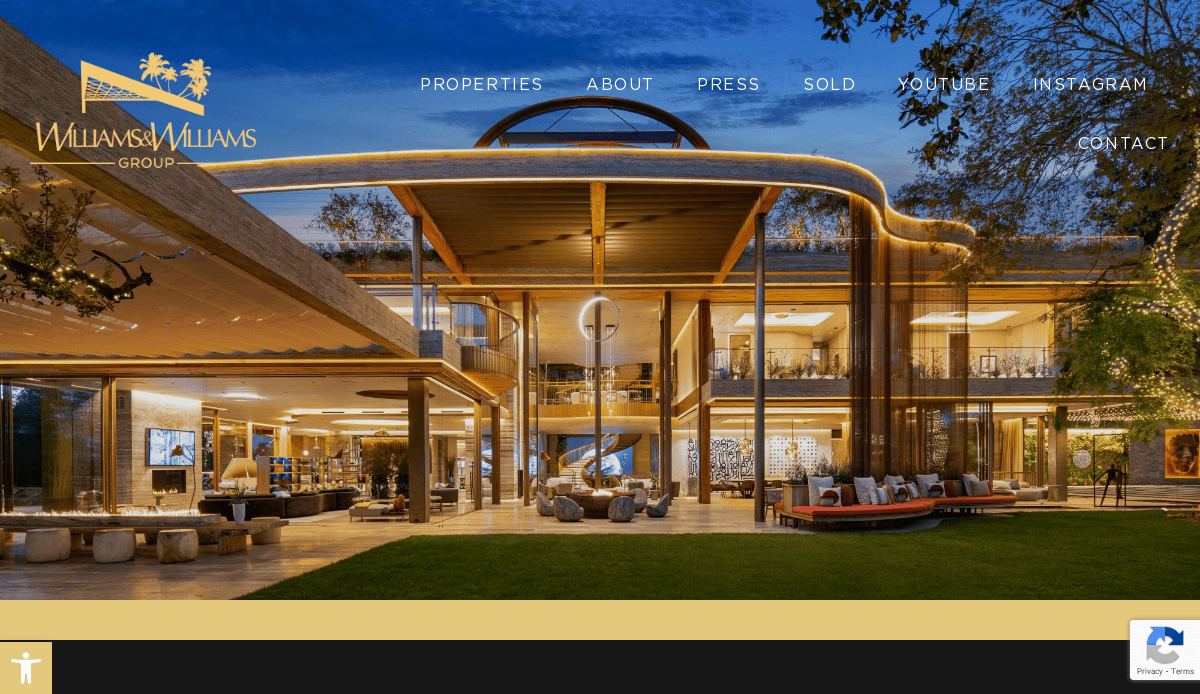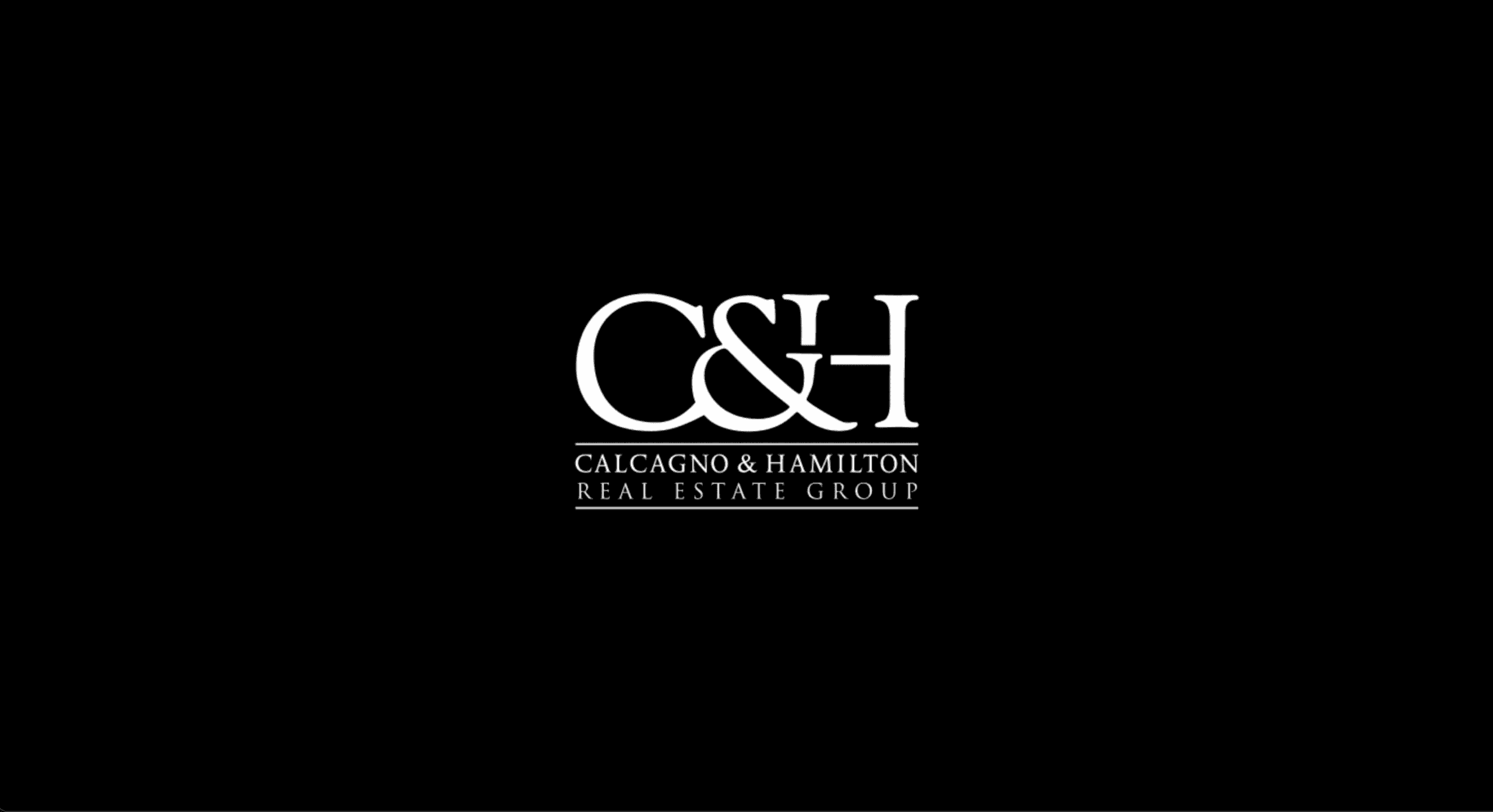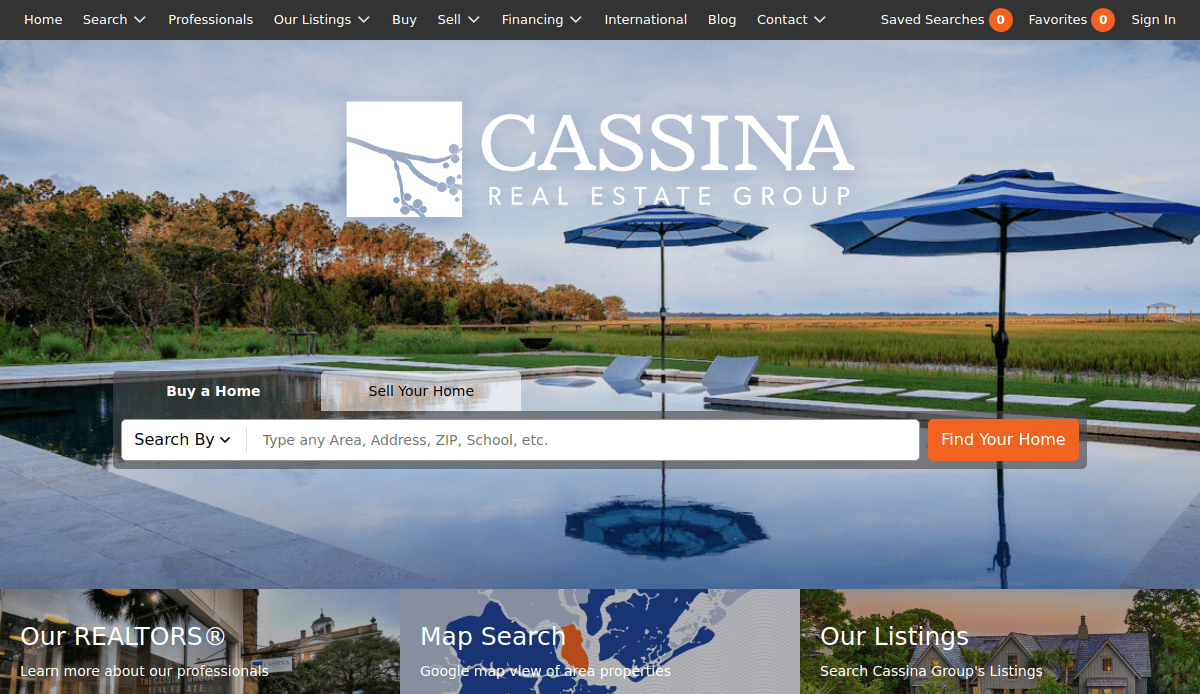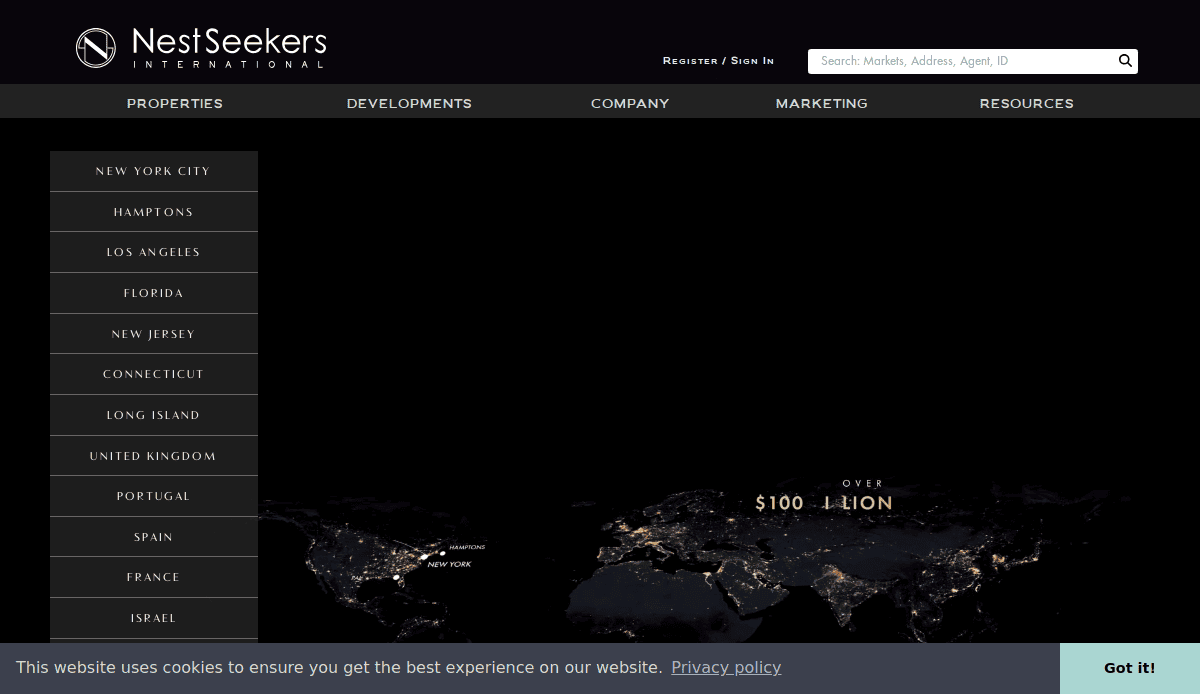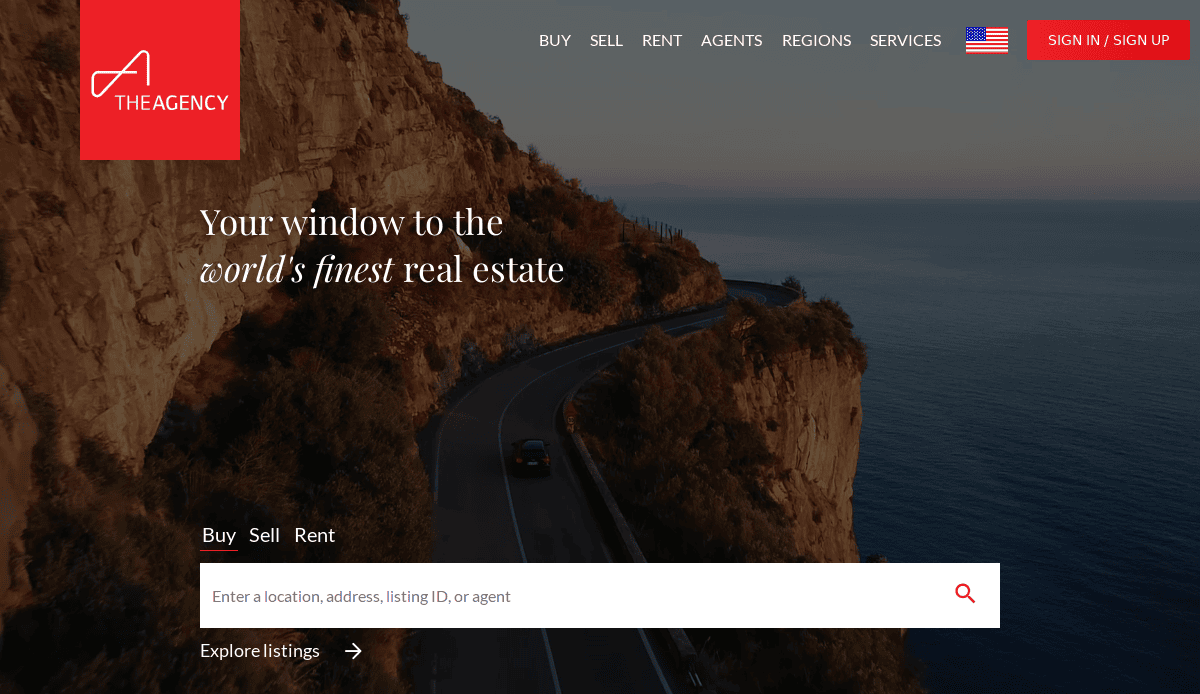Just looking for our Best Real Estate Website examples list?
Is your website costing you commissions? For most in the real estate industry, the answer is a quiet, uncomfortable “yes.” Over 75% of real estate agent websites fail to generate a single qualified lead each month. In a business where every client counts, a passive or outdated online presence isn’t just a missed opportunity—it’s a financial liability. The challenge is that the standard template you get from a generic website builder often fails to differentiate you or build trust with discerning clients. Your real estate business deserves more than a digital business card; it needs a hardworking asset.
The common “set it and forget it” approach to website design is over. To succeed today, a real estate agent needs a high-performance website that does the heavy lifting of attracting, engaging, and converting leads. Forget just having a simple landing page; the goal is to create a dynamic hub that actively works for you 24/7. This guide is engineered to make it easy for you to understand the essential components required. We will show you how to build a real estate website that becomes the engine for your growth.
This is not another list of pretty themes. This is a strategic blueprint to help you create the best real estate website for your market—one that establishes authority, captures leads, and gives you a definitive competitive edge. We’ll show you how to make your website a client-generating machine and ensure your website is finally pulling its weight.
Phase 1: Planning, Purpose, and Defining Your Digital Blueprint
Before you look at a single color scheme or font, the most critical phase of website design begins: planning. In the real estate industry, a website is not a passive online brochure; it is an active, essential tool for your real estate business. A proper plan ensures that every element of your site is built with a singular purpose: to attract your ideal client and move them to action. Skipping this step is like building a house without a blueprint—the final structure will be unstable, inefficient, and ultimately fail to serve its purpose.
Defining Your Target Audience: Beyond “Buyers and Sellers”
The first step is to precisely define who you are trying to reach. “Buyers and sellers” is too broad. A website designed to attract a first-time homebuyer in the suburbs will look and feel very different from one targeting a luxury investor in the city. To build trust effectively, you must speak directly to a specific audience.
Consider creating detailed client personas. Are you targeting:
- The First-Time Homebuyer: This individual needs educational content, budget calculators, and guidance on the buying process. Your website must make it easy for them to learn and feel secure.
- The Luxury Seller: This client expects a high-end aesthetic, professional videography, and data showcasing your track record with high-value properties. Your site must convey exclusivity and expertise.
- The Relocation Client: This person needs detailed community guides, information on school districts, and virtual tour capabilities. Your website must sell the lifestyle, not just the house.
Choosing a niche and tailoring your website’s content and design to that specific persona is the first step in creating a truly effective real estate platform.
Setting Clear Goals and KPIs for Your Real Estate Business
Your website needs a job description. What, specifically, do you want it to accomplish? Vague goals like “get more leads” are not actionable. Instead, establish clear Key Performance Indicators (KPIs) that will define success. These goals will dictate your website’s layout, content, and calls-to-action.
Examples of strong KPIs include:
- Generate 20 qualified showing requests per month through property listing pages.
- Achieve 50 “Free Home Valuation” form submissions quarterly.
- Increase newsletter sign-ups for a “Weekly Hot Sheet” by 100 subscribers per month.
- Attain a top-3 search ranking for “[Your Neighborhood] homes for sale.”
These measurable targets transform your website from a cost center into a performance-driven asset.
Analyzing the Competition and Finding Your Niche
To stand out, you must know who you are up against. This means analyzing the websites of both direct competitors (other top agents in your area) and indirect competitors (Zillow, Redfin, etc.).
When reviewing their sites, ask:
- What are they doing well? Is their property search function fast and intuitive? Is their blog full of useful local content?
- Where are their weaknesses? Is their website slow or difficult to use on mobile? Do they fail to capture leads effectively? Is their brand message generic?
- How can you differentiate? This is where you define your Unique Selling Proposition (USP). Perhaps you specialize in historic homes, waterfront properties, or a specific architectural style. Your website design must visually and textually communicate this specialty on every page, making you the obvious choice for clients seeking that expertise.
Phase 2: Key Design Principles for a High-Converting Website
Once your strategic blueprint is in place, the next phase is to translate that plan into a visual experience. For a real estate website, design is more than just aesthetics; it is the silent ambassador for your brand. An effective design builds immediate trust, communicates professionalism, and makes it easy for clients to take the next step. A poor design, conversely, can erode credibility in seconds, regardless of your skills as an agent. The following principles are essential for creating a website that looks good and performs as a powerful business tool.
Clean, Professional, and Trust-Oriented Aesthetics
Your website’s visual appeal is the first handshake with a potential client. It must convey competence and trustworthiness instantly. This is achieved through a clean, uncluttered layout that feels modern and professional.
- Brand Consistency: Your logo, color scheme, and typography should be used consistently across every page. This reinforces your brand identity and creates a cohesive, memorable experience.
- Whitespace is Your Friend: Avoid the temptation to cram every inch of the screen with information. Ample whitespace makes your content more readable, draws attention to important elements like property photos and calls-to-action, and gives your site a sophisticated, high-end feel.
- High-Quality Imagery: Use a professional headshot and high-resolution images of your target communities. Stock photos should be used sparingly, if at all. Authenticity builds trust.
User-Centric and Intuitive Navigation
If a user cannot find what they are looking for within seconds, they will leave and not return. The ultimate goal of your website’s navigation is to guide visitors to the information they need with minimal effort. The structure should be logical and predictable.
- Simple Main Menu: Your primary menu should be straightforward. Typical high-level items include: Home, Property Search, Buyers, Sellers, Community Guides, About Us, and Contact.
- The Almighty Property Search: The most crucial element for most visitors. Ensure your property search bar is prominent, preferably at the top of the homepage. The search tool itself should be powerful, with advanced filters (e.g., price range, school district, map search) that allow users to drill down to their exact needs.
- Logical User Flow: Consider the journey of each persona. A seller should be able to easily find information on your marketing process or a home valuation tool. A buyer should be effortlessly guided toward featured listings and saved searches.
Mobile-First and Responsive Design
Today, the majority of initial property searches happen on a mobile device—whether a client is in their car outside a listing or on their couch after work. A mobile-first approach is no longer optional; it is essential. This means designing the mobile experience first and then adapting it for larger screens. Every button must be easily tappable, text must be readable without pinching and zooming, and images must load quickly. Google also prioritizes mobile-friendly websites in its search rankings, so a poor mobile experience will directly harm your visibility.
Visually Driven with High-Quality Media
Real estate is a visual industry. The properties are the product, and your website must showcase them spectacularly.
- Large, Compelling Photography: Use large, high-resolution photos as the centerpiece of your listing pages. Small, pixelated images suggest a lack of professionalism.
- Video and Virtual Tours: Integrate video walkthroughs, drone footage, and 3D virtual tours directly into your listing pages. This immersive content keeps users engaged on your site for longer periods and provides a level of detail that photos alone cannot match. It demonstrates that you are a tech-forward agent who invests in marketing.
Conversion-Focused Layout and Clear Calls-to-Action
Every page on your website should have a purpose that nudges the visitor toward a specific goal. This is achieved through the strategic placement of Calls-to-Action (CTAs). Your CTAs should be visually distinct (e.g., a colored button) and use action-oriented language. Instead of a passive “Submit,” use compelling text like “Request a Showing,” “Download My Free Seller’s Guide,” or “Get Your Instant Home Valuation.” These CTAs should be placed contextually where a user is most likely to act, such as next to a property’s details or at the end of an informative blog post.
Phase 3: Structuring Content and Navigation for an Optimal User Journey
If design is the visual handshake, content and navigation are the intelligent conversation that follows. For a real estate website, your content is what builds authority and answers your clients’ critical questions, while your navigation is the map that guides them to those answers. A logical structure is essential for both user experience and search engine optimization (SEO), as it allows search engines like Google to understand and rank your site more effectively. This phase is about organizing your expertise into a clear, intuitive, and high-value digital experience.
Crafting Your Core Website Pages
Every effective real estate website is built upon a foundation of core pages, each with a distinct purpose. These pages form the backbone of your site’s navigation.
- Homepage: This is your digital storefront. It must immediately communicate your value proposition, feature a prominent and easy-to-use property search bar, showcase featured listings, include client testimonials, and guide visitors to other key areas of your site.
- About Us: This is your opportunity to build trust and create a personal connection. Go beyond a simple bio. Tell your story, explain your mission and values, and introduce your team. Use a professional headshot and consider a short introduction video.
- Property Search/Featured Listings: This is the functional heart of your website for most buyers. It must be user-friendly, with a powerful search tool, high-resolution photos, detailed property descriptions, and integrated virtual tours.
- Buyers Page: A dedicated resource for buyers. This page should outline the home buying process, offer access to a mortgage calculator, and feature lead magnets like a “First-Time Homebuyer’s Guide.”
- Sellers Page: A dedicated resource for sellers. This page should detail your unique marketing strategy for listings, provide testimonials from past sellers, and feature a clear call-to-action for a free home valuation.
- Contact Page: Make it incredibly easy for clients to get in touch. Include your phone number, email address, office address with an embedded Google Map, and a simple contact form.
The Power of Hyper-Local Content: Building Community Pages
This is where you differentiate yourself from the national portals and establish true local authority. Create dedicated pages for each neighborhood, town, or subdivision you specialize in. These are not just simple descriptions; they are comprehensive guides.
Each community page should include:
- An overview of the neighborhood’s character and lifestyle.
- Current real estate market statistics (e.g., average sale price, days on market).
- Information on local schools, parks, and amenities.
- Embedded video tours of the community.
- Testimonials from clients you’ve helped in that area.
- Active property listings for that specific community.
These pages are incredibly valuable for SEO, helping you rank for long-tail keywords like “homes for sale in [Neighborhood Name]” and positioning you as the undisputed local expert.
Developing a Content Strategy That Builds Authority (The Blog)
A blog is the single best tool for consistently attracting new traffic to your site. By creating content that addresses your clients’ pain points and questions, you build trust and demonstrate expertise. Organize your blog into categories that align with your audience’s needs.
Effective blog post topics include:
- For Buyers: “5 Things to Look for During a Final Walk-Through,” “How to Compete in a Bidding War in [Your City].”
- For Sellers: “7 Home Improvements with the Best ROI,” “The Dangers of Overpricing Your Home.”
- Local Market Updates: “The [Your City] Real Estate Market Report: [insert month and year].”
- Community Spotlights: “A Local’s Guide to the Best Restaurants in [Neighborhood].”
Designing an Intuitive Navigation Menu
Your navigation menu ties all of your content together. It should be simple, logical, and consistent across your entire website.
- Primary Menu: Keep the main navigation bar at the top of the page clean and uncluttered. It should feature links to your core pages (Home, About, Buyers, Sellers, etc.). Use dropdown menus to house your community pages under a single “Communities” or “Neighborhoods” tab to avoid clutter.
- Footer Menu: The website footer is the place for secondary links that don’t need to be in the main menu. This includes links to your social media profiles, privacy policy, terms of service, and any agent career opportunities.
Phase 4: Mastering Visual Elements to Build Your Brand and Engage Users
In the real estate industry, what you see is what you sell. Visual elements are not decorative accents on your website; they are the core of your marketing and the foundation of your brand’s perceived value. High-quality visuals establish professionalism, build immediate trust, and allow potential clients to form an emotional connection with a property before they ever step inside. This section covers the critical visual components that transform a simple website into an immersive and persuasive brand experience, directly impacting user engagement and business results.
High-Resolution Photography: Your Most Valuable Asset
Your most important visual asset is professional photography. This is a non-negotiable element where cutting corners will actively harm your business. Grainy, poorly lit, or smartphone-quality photos signal a lack of professionalism and can drastically reduce a property’s perceived value.
- Property Photos: Every listing must be represented by a suite of high-resolution, professionally shot photographs. These images should be large, crisp, and showcase the property’s best features in the best possible light.
- Community Imagery: Your hyper-local community pages should feature authentic, high-quality photos of the neighborhoods you serve. Showcase the parks, the main street, the local landmarks—the things that make a community unique. This helps sell the lifestyle, not just the home.
- Professional Headshots: Your “About Us” page and agent profiles require a professional, high-quality headshot. This is often the first “meeting” a potential client has with you, and it must build a sense of trust and competence.
Immersive Video and Virtual Tours: The Modern Open House
Static photos will no longer be enough. Buyers, especially those relocating, expect a more immersive experience. Video content meets this expectation, dramatically increases user engagement and the amount of time visitors spend on your site, a key factor for SEO.
- Agent-Led Video Walkthroughs: A video of you or another agent walking through a property adds a personal touch and allows you to highlight features and tell a story that photos cannot.
- 3D Virtual Tours: Technologies like Matterport allow users to virtually walk through a home at their own pace. Offering this on your listings provides immense value and can help pre-qualify buyers.
- Drone Footage: For properties with significant land, a unique location, or impressive exterior features, aerial drone video provides a stunning perspective that can set your listing apart.
- Brand and Community Videos: A short brand video on your homepage or a “Welcome to the Neighborhood” video on a community page can quickly communicate your value proposition and expertise.
Branding: Creating a Cohesive and Memorable Visual Identity
Strong branding differentiates you in a crowded market. Your visual brand is the consistent look and feel that ties all your marketing materials together, from your website to your “For Sale” signs.
- Professional Logo: Your logo should be simple, memorable, and designed for versatility across digital and print formats.
- Strategic Color Palette: Choose a color scheme of two to three primary colors that reflects your brand’s personality (e.g., blues and grays for trust and stability; bolder colors for a modern, energetic brand). Use these colors consistently for buttons, links, and headings.
- Consistent Typography: Select two legible, professional fonts—one for headings and one for body text—and use them throughout your site. This creates a clean, cohesive reading experience.
Infographics and Data Visualization: Making Complex Information Digestible
Real estate is full of data, from market trends to the steps in the closing process. Instead of presenting this as dense text, use simple visual tools to make it understandable and engaging.
- Market Trend Graphs: Use simple bar charts or line graphs on your community pages or blog posts to show changes in average home prices or days on market.
- Process Infographics: Create a simple, visually appealing infographic to illustrate the steps of the home buying or selling process. This makes the journey less intimidating for clients and positions you as a helpful guide.
Phase 5: Ongoing WordPress Maintenance for Peak Performance
Launching your real estate website is the beginning, not the end, of the process. Like a well-maintained home, your WordPress website requires regular upkeep to perform at its best, remain secure, and provide a seamless experience for your clients. Neglecting maintenance can lead to slow load times, broken features, and critical security vulnerabilities that can damage your business and reputation. Consistent, proactive maintenance ensures your digital asset continues to generate leads and build your brand long after its initial debut.
Regular Software Updates: Your First Line of Defense
The WordPress platform, along with its themes and plugins (like your essential IDX plugin), receives regular updates from developers. These are not just for adding new features; they are critical for the health and security of your website.
- WordPress Core Updates: These updates often contain vital security patches that protect your site from the latest known threats. Running an outdated version of WordPress is a common entry point for hackers.
- Theme and Plugin Updates: Developers constantly refine their code to fix bugs, improve performance, and patch security holes. A real estate site relies heavily on plugins for IDX feeds, contact forms, and more. Keeping these updated ensures compatibility and prevents features from breaking. An out-of-date plugin can create conflicts that bring down your entire site.
Security and Monitoring: Protecting Your Business and Clients
A real estate website handles sensitive information, from client inquiries to potentially saved property searches. A security breach can be devastating to the trust you’ve built.
- Active Security Monitoring: Implement a security plugin (like Wordfence or Sucuri) to scan for malware, monitor for suspicious login attempts, and alert you to potential threats. A firewall can proactively block malicious traffic before it reaches your site.
- Strong Password Policies: Enforce the use of strong, unique passwords for all user accounts, especially administrators. Avoid common usernames like “admin.”
- Limit User Permissions: Not everyone on your team needs administrator access. Assign roles and permissions based on what each user needs to do, limiting the potential damage if a single account is compromised.
Performance Optimization: Ensuring a Fast User Experience
In real estate, speed matters. A potential client will not wait for slow-loading property photos. If your site is sluggish, visitors will leave and go to a competitor or a major portal.
- Image Compression: Real estate sites are image-heavy. Use a plugin to automatically compress and optimize images upon upload without sacrificing quality. This is one of the most effective ways to improve page load times.
- Caching: Implement a caching plugin to store static versions of your pages. This reduces server load and delivers content to repeat visitors much faster, creating a snappier user experience.
- Database Maintenance: Over time, your WordPress database can become bloated with post revisions, spam comments, and transient data. Regularly cleaning and optimizing your database keeps it running efficiently.
Backup and Recovery: Your Digital Insurance Policy
Even with the best security measures, issues can arise. A faulty update, a user error, or a successful hack could take your site offline. A reliable backup and recovery plan is your safety net.
- Automated, Regular Backups: Your website should be backed up automatically on a frequent schedule (daily is best for an active real estate site). This includes both the website files and the WordPress database.
- Off-Site Storage: Backups should be stored in a secure, off-site location, such as a cloud storage service (e.g., Google Drive, Dropbox) or a dedicated backup solution. Storing backups on the same server as your website is risky, as a server failure could wipe out both.
- Test Your Backups: A backup is only useful if it can be successfully restored. Periodically test your recovery process to ensure that you can get your site back online quickly and effectively in an emergency.
20 Real Estate-Related Web Design Examples
A great website serves as a digital storefront, a lead generation engine, and a testament to an agent’s or brokerage’s brand and expertise. Below are 20 of the best real estate-related websites, showcasing exceptional design, user experience, and strategic marketing. Five of these examples are designed by our experts, demonstrating a clear understanding of what real estate professionals need to succeed online.
1. McCormick Real Estate & Management
Location: Sycamore, IL
Key Takeaways:
- Clear Service Differentiation: The website does an excellent job of immediately separating its two main business lines—Real Estate Sales and Property Management—preventing user confusion.
- Community-Centric Branding: The use of clean, professional imagery of the local Sycamore area and a straightforward design builds a sense of trust and community focus.
- Action-Oriented Navigation: The menu uses clear, actionable language like “Find a Home,” “List Your Home,” and “See Our Rentals” to guide users directly to their goals.
2. The Sokody Sales Group
Location: Grand Island, NY
Key Takeaways:
- Community-Focused Imagery: The use of high-quality local imagery creates a strong connection to the Western New York market it serves.
- Prominent Testimonials: Placing client testimonials front and center builds trust and social proof with new visitors.
- Direct Calls-to-Action: Buttons like “Get Your Home’s Value” and “Start Your Search” are clear, concise, and guide the user journey effectively.
3. The Ville Team
Location: Plainfield, IL
Key Takeaways:
- Modern & Clean Aesthetic: The website utilizes ample white space and a clean layout, giving it a sophisticated and professional feel.
- Video Integration: The embedded video on the homepage adds a dynamic element and allows the team to tell their story more effectively than text alone.Featured Communities Section: This dedicated section helps build topical authority for local SEO and provides immense value to users researching specific neighborhoods.
4. Schiller Real Estate
Location: Elmhurst, IL
Key Takeaways:
- Hyper-Local Authority: The website immediately establishes its deep roots and expertise in Elmhurst and the surrounding DuPage County.
- Prominent Agent Roster: It features a clear, professional agent directory that builds trust by showcasing the team’s experience and making it easy for visitors to connect with a specific person.
- Clean, Functional Design: The site prioritizes function and speed, with a no-nonsense layout that makes property searches and accessing resources straightforward for all users.
5. The Chase Real Estate
Location: Chicago, IL
Key Takeaways:
- Bold First Impression: The site uses a striking, full-screen video background of the Chicago skyline to create a high-impact, memorable first impression.
- Dual Calls-to-Action: It effectively funnels visitor traffic with a simple, clear choice right away: “Explore Our Developments” or “Explore Our Brokerage,” catering to two distinct audiences.
- Minimalist & Sophisticated: The design is clean and minimalist, using space and bold typography to create a high-end, luxury feel that aligns with its development projects.
6. The Oppenheim Group
Location: Los Angeles, CA
Key Takeaways:
- Luxury Branding: The sleek, dark theme and cinematic visuals immediately convey exclusivity and high-end market expertise.
- Press & Media Integration: Featuring high-profile media mentions (“Selling Sunset”) provides powerful social proof and builds brand authority.
- Agent-Forward Design: The site heavily promotes its agents as stars, which helps build individual brands within the brokerage.
7. Ryan Serhant
Location: New York, NY
Key Takeaways:
- Bold Personal Brand: The entire website is a masterclass in personal branding, positioning Ryan Serhant as a media mogul, not just a broker.
- Multiple Content Streams: Integrating his blog, vlog, and courses turns the site into a media hub that captures leads from multiple funnels.
- Dynamic Visuals: The use of high-energy video and professional photography creates an engaging and memorable user experience.
8. The Jills Zeder Group
Location: Miami Beach, FL
Key Takeaways:
- Stunning Photography: The website leads with breathtaking, high-resolution images of luxury properties that immediately capture attention.
- Data-Driven Proof: Featuring impressive sales statistics ($ 1 B+ in 2023) right on the homepage instantly establishes credibility and success.
- Elegant User Interface: The refined typography and clean layout provide a sophisticated browsing experience befitting a luxury brand.
9. Tim Allen Properties
Location: Carmel, CA
Key Takeaways:
- Focus on Lifestyle: The website effectively sells the aspirational lifestyle of Carmel and Pebble Beach, not just the homes themselves.
- Immersive Video Backgrounds: The use of high-quality video on the homepage immediately draws the user into the scenic local environment.
- Clean & Classic Design: The design is timeless and elegant, appealing perfectly to the high-end demographic of its target market.
10. The Bernardi Group
Location: Aspen, CO
Key Takeaways:
- Niche Market Authority: The entire site is dedicated to the Aspen/Snowmass market, showcasing deep local expertise.
- High-Quality Property Videos: The prominent use of professional video tours for listings enhances the user experience and property marketing.
- Clear Navigation Paths: Users can easily choose their path, whether they are interested in buying, selling, or renting, with clear menu options.
11. Smith & Berg Partners
Location: Los Angeles, CA
Key Takeaways:
- Unique Brand Voice: The site uses a confident, slightly edgy tone (“Tacos are our love language”) that makes the brand memorable and approachable.
- Magazine-Quality Content: Their “The Address” blog feels more like a high-end lifestyle publication than a typical real estate blog.
- Strong Team Emphasis: The focus on the team as a collective (“us”) builds a strong sense of a collaborative and capable group.
12. Dawn McKenna Group
Location: Chicago, IL (and other luxury markets)
Key Takeaways:
- Multi-Market Expertise: The site does an excellent job of catering to multiple luxury locations (IL, FL, MI, WI) from a single, cohesive platform.
- Interactive Magazine: The “DMG Lifestyle” section is a rich, interactive resource that provides value beyond property listings.
- Sophisticated Property Search: The search functionality is robust, allowing users to filter by market and lifestyle, which is crucial for their diverse audience.
13. The Ivan Sher Group
Location: Las Vegas, NV
Key Takeaways:
- Striking Visuals: The site uses dramatic, high-contrast photography that reflects the glamour and luxury of the Las Vegas market.
- “As Seen In” Credibility: A prominent section showcasing features in major publications like the Wall Street Journal builds immense trust.
- Easy-to-Navigate Neighborhoods: The “Communities” section is visually driven and makes it simple for buyers to explore different areas.
14. Joyce Rey
Location: Beverly Hills, CA
Key Takeaways:
- Legacy & Experience: The branding emphasizes her decades of experience, positioning her as a legendary figure in real estate.
- Classic, Elegant Design: The website avoids overly trendy designs in favor of a classic, refined look that signals stability and authority.
- Global Reach Highlight: The affiliation with Coldwell Banker Global Luxury is prominently displayed, highlighting her international network.
15. Williams & Williams Estates Group
Location: Beverly Hills, CA
Key Takeaways:
- Architectural Focus: The website often highlights the architect or designer of a property, appealing to a sophisticated, design-conscious clientele.
- Minimalist Aesthetic: The clean, minimalist design puts the focus squarely on the stunning property photography.
- Press as a Portfolio: Their extensive press section is used effectively to showcase their most significant sales and media presence.
16. Michael Calcagno & Nancy Hamilton
Location: Santa Barbara, CA
Key Takeaways:
- Approachable & Friendly Branding: The color scheme and team photos create a warm, welcoming vibe that stands out from more corporate brokerages.
- Clear Process for Buyers/Sellers: The site neatly outlines the steps for buying and selling, which is incredibly helpful for first-time clients.
- Strong Community Vibe: The focus on “Creating Homes” feels personal and community-oriented.
17. The Cassina Group
Location: Charleston, SC
Key Takeaways:
- Exceptional Local Photography: The website beautifully captures the unique charm and history of the Charleston area.
- Intuitive Map Search: Their map-based search is highly effective and a primary feature on the homepage, catering to how users want to find properties.
- Resource-Rich Blog: The blog provides valuable information on the local market, events, and lifestyle, establishing them as local experts.
18. Richardson Properties
Location: San Luis Obispo, CA
Key Takeaways:
- Lifestyle-Driven Content: The site effectively sells the Central Coast lifestyle with beautiful imagery and content about local life.
- Clean & Uncluttered Layout: The design is easy on the eyes and makes finding information, from listings to agent bios, effortless.
- Prominent Affiliations: Highlighting their affiliation with Christie’s International Real Estate adds a layer of prestige and trust.
19. Nest Seekers International
Location: New York, NY
Key Takeaways:
- Global Brand Presence: The website successfully conveys the brokerage’s international reach and extensive network.
- Focus on New Development: There is a strong emphasis on new development projects, catering to investors and high-net-worth individuals.
- Integrated Media Arm: The “Nest Media” division is featured prominently, showing their commitment to high-quality, modern marketing.
20. The Agency
Location: Beverly Hills, CA
Key Takeaways:
- Bold & Modern Branding: The strong red and black color scheme and modern typography are instantly recognizable and confident.
- Global Luxury Focus: The site seamlessly integrates listings from around the world, reinforcing its image as a global luxury powerhouse.
- “Red Paper” Reports: Offering proprietary market reports positions them as thought leaders and provides a valuable lead-capture tool.
Your Blueprint for a Successful Real Estate Website
You now have the ultimate guide for creating a website that performs as hard as you do. We’ve explored how a strategic approach to real estate web design is crucial for real estate professionals who want to thrive in the competitive online real estate market. Remember that your website is a digital storefront, and for the many buyers who start their real estate journey online, its first impression is everything. A successful real estate website isn’t just about how it looks; it’s about providing value, from insightful website content to an intuitive real estate search experience. The complexities of real estate demand a platform that can handle it all. Following this guide for creating a site that is both beautiful and functional is one of the best ways to ensure you capture more leads on your website.
Building a website that stands out requires more than a template from common website builders. It demands expertise in user experience, local SEO, and the specific website features a modern real estate professional needs to succeed. If you’re ready to stop wrestling with code and plugins and start focusing on what you do best—closing deals—let our expert real estate team help.
Frequently Asked Questions About Real Estate Website Design
How much does it cost to build a new real estate website?
The cost of building your website varies significantly based on the type of website you need. Using basic website builders like Wix or Squarespace can be cheaper upfront, but they often lack the crucial IDX integration and customization needed. A custom WordPress site built by a professional website designer is a larger investment but provides a scalable foundation that best aligns with your needs for lead generation and brand building. The investment should be weighed against the potential return from even a single real estate transaction sourced from the site.
What are the absolute must-have features my real estate website needs?
Every successful website must have several core features. The most critical is a fast, reliable, and user-friendly IDX property search. Other essentials include high-resolution photo and video galleries for your listings on your website, clear calls-to-action, testimonials from past clients, and easy-to-use contact forms on your website. Your site must also be mobile-first, as most buyers start their real estate search on their phones.
What is IDX, and why is it so important?
IDX, or Internet Data Exchange, is the system that allows you to display the most up-to-date MLS property listings directly on your site. It is the single most important tool for keeping website visitors engaged. Without it, users searching for real estate will leave your site and go to Zillow or a competitor. An effective IDX integration ensures that your website and its properties look professional and that you are the one capturing the lead, not a major portal.
Can I really compete with big portals like Zillow and Redfin for SEO?
Yes, absolutely—but you must be strategic. You won’t outrank them for broad terms, but you can dominate local search. The key is adding real-estate-related keywords with a hyper-local focus. By creating detailed community pages and blogging about local real estate topics, you provide niche value that Zillow cannot. This strategy helps you rank for long-tail keywords and attracts highly qualified traffic relevant to your real estate business. Visit this list of top-performing realtor websites for more inspiration.
Should I choose a website builder or hire a professional web designer?
When you choose a website builder, you gain control but often sacrifice functionality and scalability. While they seem easy, making a generic template into a real estate website that stands out can be challenging. Hiring a professional website designer or agency like ours ensures that the technical aspects—from your hosting solution that best aligns with your expected website traffic to complex IDX integration—are handled correctly. A professional ensures your website looks credible and is built from the ground up to convert visitors into leads.

